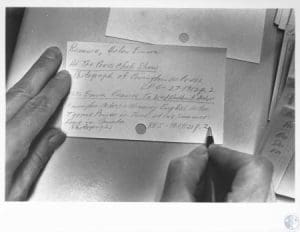If you are interested in digging into the stories of your family tree, the New Year is a great time to start and begin to learn more about your heritage!
The Local History & Genealogy Department has a large collection of microfilm, print, and electronic resources to help answer your genealogical questions. Here are five tips to help you get started with your genealogy research:
- Interview and Document!
A great place to begin is by interviewing family members: parents, grandparents, aunts, uncles, and cousins to collect background information. Asking about names of parents and siblings, places of birth, burial, family traditions, stories passed down about ancestors, etc. can be a great jumping off point for your research. Be sure to write down their answers or record the interview if they are willing!
- Research Questions
Research questions help to focus your research and avoid inefficiency. This involves creating effective research questions which concern aspects of identity, relationship or events.
- Identify Sources
After developing a research question, the next step is to identify your sources. Check out our KCPL Local History Guide to view a list of the print, microfilm, and electronic databases that we have available to help you with your genealogy research!
Be sure to visit our GeNKY database, where we have thousands of records digitized and available to search from our archival collection. This includes yearbooks, cemetery records, church records, and much more. Our Faces and Places database also contains over 119,000 archival photographs of Northern Kentuckians.
Within our genealogy page, you can also explore our historic newspaper databases, which includes access to Newspaper.com world edition, The Kentucky Post, The Cincinnati Enquirer, Newspaper Archive and others. Access to FindMyPast, MyHeritage, Ancestry Library Edition, Fold3, and our Kentucky Sanborn Fire Insurance Maps is also available here.
- Research!
Now that you have identified a few sources to look into to help answer your research question, the next step is to do the research!
To make the most out of your searches, we recommend utilizing the card catalog within databases such as Ancestry Library Edition and FamilySearch. This way, you can search within a specific record set, rather than searching the entire database. This will save time and improve the precision of your search results.
- Analyze
After researching and identifying a couple of sources to help answer your research question, you’ll want to analyze the records that you have found to help determine their reliability.
Are the records original records or derivative records? Original records tend to be the most accurate and were recorded soon after the event took place. Derivative records are non-original records that are based on a previously created record. An example of this would be family histories, indexes, transcriptions, or abstracts.
You can ask questions such as these to help determine the reliability of a record. Correlating information such as names, dates, and locations will help you to confirm if a record is a match for the individual/family that you are researching.
- Who created the record?
- When and where was the record created?
- Who provided the information for the record?
- What kind of information is incomplete in the record?
Join us on our YouTube channel on Friday, January 21 at 2:00 as we explore additional research tools and strategies for beginning your family research!




Add a comment to: Genealogy: Getting Started